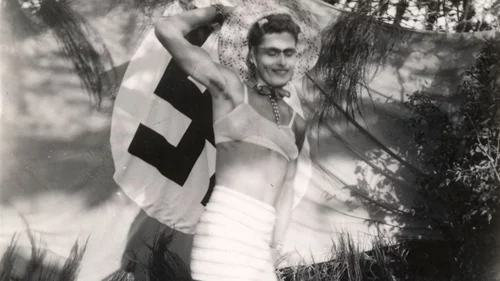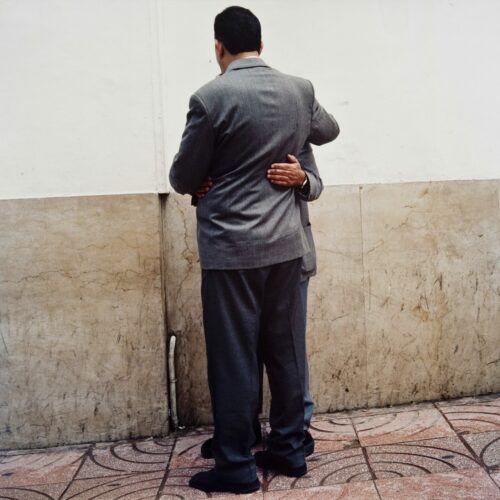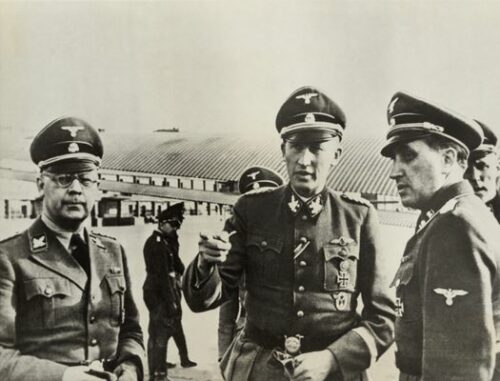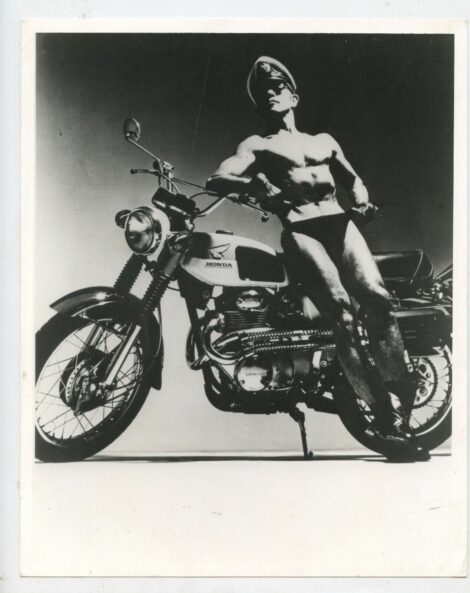
Sylvain Couzinet-Jacques, photography.
“Just as the capitalist system continuously produces and reproduces itself economically on higher and higher levels, the structure of reification progressively sinks more deeply, more fatefully and more definitively into the consciousness of man.”
Georg Lukacs (History and Class Consciousness)
“The whole point is to show that human beings have lost their instincts, especially their sexual instinct and, more specifically still, their instinct to reproduce.”
Jean Laplanche (New Foundations of Psychoanalysis)
“Sex is always political.”
Gayle Rubin (Thinking Sex)
“While it is indisputably true that sexuality is always being politicized, the ways in which having sex politicizes are highly problematical.Right- wing politics can, for example, emerge quite easily from a sentimentalizing of the armed forces or of blue- collar workers, a sentimentalizing which can itself prolong and sublimate a marked sexual preference for sailors and telephone linemen.”
Leo Bersani (Is the Rectum a Grave)
I want to write with the lecture series (People’s University) in mind. So I wanted to continue to clarify what I was discussing in broad terms with that first lecture. Anytime theatre and space (and this is going to include cinema at some point) is discussed, one is going to have examine architecture. And there are both similarities with film and theatre, and important differences. And I wanted to continue examining the contemporary war fever and seeming unreality of not just Zionist genocide, but of the sabre rattling and bellicose rhetoric coming from EU politicians and, naturally, US politicians. The reemergence of fascist symbolism and discourse seems to be unfolding exponentially. Certainly the public has become more aware of this due to the genocide unfolding in Gaza. And, more pointedly, in the language and presentations of the Zionists themselves. And the open feting of former Nazis and Nazi collaborators.
“His approach to the subjectivity of the soldier males derives not from Freud or Lacan, but from Deleuze and Guattari’s heterodox Anti-Oedipus, published in the early 1970s. According to Deleuze and Guattari, the Oedipal structure is not a human universal, as Freud and some anthropologists have attempted to demonstrate, but rather a determinate social relation enforced from above (Theweleit I: 210). In the anti-Oedipal model, the concept of unlimited desire dis- places Oedipus as the universal upon which the theorists found their model. The anti-Oedipal model privileges neither the father nor the phallus (II: But rather the subject’s relation to its own desiring-production.) { } The Freikorps sees itself engaging in “a battle against everything that constitutes enjoyment and pleasure” According to this psychoanalytic model, the very tenuousness of the soldier male’s ego, the fact that he is “not yet fully born” (II: 213), requires him to establish “maintenance mechanisms” as a prop to identity. The soldier male’s ego comes not from identification with the father, as in the Oedipal model, but, rather, through punishment.”
Michael Rothberg (Documenting Barbarism: Yourcenar’s “Male Fantasies”, Theweleit’s “Coup”)

David Favrod, photography.
“Fascist propaganda has only to reproduce the existent mentality for its own purposes;-it need not induce a change-and the compulsive repetition which is one of its foremost characteristics will be at one with the necessity for this continuous reproduction. It relies absolutely on the total structure as well as on each particular trait of the authoritarian character which is itself the product of an internalization of the irrational aspects of modern society. Under the prevailing conditions, the irrationality of fascist propaganda becomes rational in the sense of instinctual economy.”
Theodor Adorno (Freudian Theory and the pattern of Fascist Propaganda)
So first I wanted to touch on the strange and perhaps even uncanny confluence between gay culture and fascism.
The uncanny aspect here is important because one would have to define what is meant by homosexual, firstly. That there are huge numbers of socialists and radicals and leftists who are also gay should be obvious. The fact that there are many, for example, state raised ex offenders who prefer sex with other men, but harbour desire for women, clouds definitions. So this is more about a process in contemporary life that seeks to brand everything, including identity. The gay-rights movement has felt increasingly appropriated by affluent and privileged gay white men. The ‘boys town’ areas of many big cities in the US are in nearly all cases the most policed and restricted. They are almost gay fortresses and the community itself works hard and in cooperation with city councils and government to enact parking laws and property rights that assist in this fortress mentality. The police that once brutalized gay areas (and still do in many places) now work alongside the more affluent representatives of the group once discriminated against. The evolution of gayborhoods (sic) is a history of dealing with discrimination, however. And this history mirrors the history of the U.S. class system altogether. But it also a story of gentrification and the contradictions within that narrative.
see https://www.ncbi.nlm.nih.gov/pmc/articles/PMC7978650/
and perhaps more to the point https://metropolitiques.eu/All-the-Gayborhoods-are-White.html
“The totalitarian state endowed the human body with a monumental status before flattening it in a field of endless mimetic reproduction, the reach of which mirrored the state’s expansionist aims and its claim to an idealized human form. This futuristic (to some, dystopian) feature of modernist politics demonstrated a wide spread mode of social representation that reached its apex in the architecture of the 1950s. The state could declare itself an “achieved community,” as Susan Sontag has observed, characterized by a “triumph over everyday reality” through “ecstatic self-control and submission.”
Nicholas Gamso (Fascist Intrigue and The Homo–Spatial Imaginary)

Delio Jasse, photography. (Luanda, Angola)
“The essential role of narcissism in regard to the identifications which are at play in the formation of fascist groups, is recognized in Freud’s theory of idealization. “We see that the object is being treated in the same way as our own ego, so that when we are in love a considerable amount of narcissistic libido overflows on the object. It is even obvious, in many forms of love choice, that the object serves as a substitute for some unattained ego ideal of our own. We love it account of the perfections which we have striven reach for our own ego, and which we should now like to procure in this roundabout way as a means of satisfying our narcissism. “It is precisely this idealization of himself which the fascist leader tries to promote in his followers, and which is helped by the Fuhrer ideology.”
Theodor Adorno (Freudian Theory and the pattern of Fascist Propaganda)
But here I want to discuss again, this idea of fascist aesthetics and its durability in the modern psyche. And how there seemed a fascist hierarchy that allowed a certain privilege to the practitioners of specific dog whistles and style codes. But also, that the psychological profile of today’s liberal is nearly identical to the followers of the Reich. That the spaces of modern capitalism are the spaces of authoritarian design.
“Le Corbusier, for example, described Hitler’s attempt to expand the German republic as “a magnificent work: the remaking of Europe.” This was no less the case for Johnson, whose enthusiasm for erotic Nazi spectacle was recorded by his biographer Franz Schulze:”You simply could not fail to be caught up in theexcitement of it, by the marching songs, by the crescendo and climax of the whole thing, as Hitler came on at last to harangue the crowd.” According to Wortman, (Phillip) Johnson “could not separate the energy of the orchestrated frenzy from the day’s sexual charge either, feeling thrilled at the sight of ‘all those blond boys in black leather’ marching past an ebullient fuhrer.{ }The homosocial practices and hypermasculine aesthetics of the Nazis generated both ambivalence and desire with regard to an array of political and sexual subcultures. This will perhaps account for the subversive and parodic character of subsequent iterations of homo-fascist aesthetics. When artists like Tom of Finland and filmmaker Kenneth Anger produced a growing corpus of erotic representations featuring explicit Nazi imagery, it was less to make an ideological claim than to uncover some repressed homosexual attraction in the brutish excesses of modern masculinity”
Nicholas Gamso (Ibid)

Hugo Jaeger, photography (Hitler dining, to his right is wife of Albert Forster. apprx 1938)
The crypto-authoritarian in design is everywhere, if one just looks. And it is certainly evident in all the various versions of ‘wokeness’ one sees daily. And one sees the conforming sensibility in various movements whose primary focus (equality for their interests in some form or other) grants a secondary obedience to the prevailing ideology. (for example a conformity to the Covid lockdowns, or a reflexive agreement with climate discourse, etc). Those discriminated against in housing or hiring or benefits will reflexively bend over backwards to accommodate the authority figure, or institution, in other matters. It is partly trained and learned subservience. Organizational impulses are short circuited at inception almost.
“A great writer turns his/her reader into an architect, who keeps erecting rooms, buildings and entire cities in his/her imagination as the story progresses.”
Juhanni Pallasmaa (The Existential Image: Lived Space in Cinema and Architecture)
And this process of an architectural imaginary takes place in film as well, only diluted to a much greater degree. And I say diluted because today’s filmmakers have not read. The films of Antonioni or Pasolini or Fassbinder were very much akin to a Dostoyevski or Henry James in the houses in these fictive interior landscapes. This is not true today. A mini series like Eric (since I mentioned that on the Theatre lecture) exist in spaces without architecture in a sense. There is real estate, but no architecture. The creators don’t read. And so what happens to the audience trying to become this interior architect? I would suggest this introduces a new level of frustration — or more, a new sense of maladjustment.
“What has been repressed in the resulting version of “scopophilia” is that which is most central to psychoanalysis: the unconscious, and therefore any acknowledgment of the active/passive duality of the drives to which Freud refers in his remark on the unconscious counterpart of exhibitionism. There is no objectification without identification.”
Victor Burgin (Optical Space, Psychical Space)

Constantin Schlachter, photography.
Burgin is criticizing, respectfully, Laura Mulvey’s famous essay Visual Pleasure and Narrative Cinema for not including the unconscious in her positing of this Euclidean optical space. Dreams, Burgin and Freud both note, show no respect for the optical rules of Euclid or anyone else. The point here is there is a sort of bourgeois resistance to letting go of those rules.
“The attraction of the cone-of-vision model for a critical theory of visual representations is the explicit place it allocates to the subject as an inherent part of the system of representation. The major disadvantage of the model is that it maintains the object as external to the subject, existing in an untroubled relation of “outside” to the subject’s “inside.” As I observed, the predominance of the optical model has encouraged the confusion of real space with psychical space; the confusion of the psychoanalytic object with the real object.”
Victor Burgin (Ibid)
There is a political aspect to this. And the political exists for both the psychoanalytic and the real. Only in differing ways. If I am right about the ur-space of theatre, of the human psyche, then the psychoanalytic object is always going to be autobiography. And the real is always going to be Desire. The bourgeois subject identifies with the rules of optics — as he or she does with all rules.
“The object … this breast is not only a symbol. There is a sort of coalescence of the breast and the erogenous zone . . . the breast inhabits the lips or the buccal cavity…Similarly the aim…undergoes a radical change. With the passage to incorporation, suddenly something new emerges: the permutability of the aim; we pass from “ingest” not to “incorporate” but to the couple “incorporate/beincorporated”…in this movement of metaphorization of the aim, the subject (the carrier of the action) suddenly (I do not say “disappears,” but) loses its place: is it on the side this time of that which eats, or the side of that which is eaten? “
Jean Laplanche (Sublimation)
Ambivalence. From the very beginning our psyche experiences ambivalence.

Dexter Dalwood (Sharon Tate House)
Now, it is worth looking more at the erotic codes of fascism. And I am reminded of this quote:
“I’m convinced that it is the psychopathic personality that searches out a uniform. There’s little doubt of what’s going on in that man’s head who will voluntarily don any uniform.”
George Jackson (Soledad Brother)
There seems to a minor renaissance (again) of the work of Tom of Finland (aka Touko Laaksonen). And it is interesting that this work is, probably, at best decent graphic design, it came to represent more, in the 60s and 70s, for the gay community. And there are multiple layers at work in Tom’s drawings. Judith Halberstam (now Jack Halberstam) has a pretty cogent analysis of gay porn and fascism.
“…the utopian jouissance seems primarily available only in relation to male- male anal sex between strangers.”
Judith Halberstam (The Queer Art of Failure)
And per Jackson’s quote, then, the psychopathology of this theatre of tricking, is in need of a deeper (sic) analysis. The interpretation of work like Tom of Finland is, obviously, intensely mediated by sexual politics; the original audience for Laaksonen’s work as a narrowly prescribed gay readership, mostly closeted. It appeared in magazines for physical culture. But the rough trade subtext is, actually, not a sub text. The theatrics of anonymous gay sex, especially from the pre AIDs days, was self consciously transgressive. If sex is to be heightened by fear of exposure, and performed dangerously in public parks or warehouse districts, then the next tier of these mini queer dramas is the uniform. The uniform, military, police, or even guard, is an avatar of society’s institutional authority. There is a sub text of rape in many of these mini performances,. Replicating jail rape or shipboard rape.

Martin Dammann, photography (Found photos of German soldiers WW2)
There are, however, more dialectical readings of these scenes of abjectiion. The aesthetics associated with Jean Genet are hugely relevant here. So, what separates Querelle from Tom of Finland?
Here is a pretty good review of the Fassbinder version of Querelle…
https://graham-russell.blogspot.com/2011/07/reflections-on-querelle-1982.html
Maybe that’s the wrong question. Tom of Finland is an illustrator. A pretty decent one, actually. And in a sense can be treated, critically, the same way as R.Crumb. But the crucial aspect, really, is the Nazi/fascist connection. And the recent Martin Dammann book of found photographs of WW2 German (Nazi) soldiers in drag underscores all this. The interesting aspect of Dammann’s book, as he himself notes, is that he didn’t go looking for these photos, but as he collected WW2 images he kept finding more and more and MORE of cross dressing Nazi soldiers. Now the erotically transgressive aspect of National Socialist iconography probably pre-dates the rise of Hitler and his party. Weimar Germany was a highly conflicted and erotized culture. (see Cabaret for a kitsch version). And this from Berliner Tageszeitung, in 1987, in an article by Hans Georg Stümke “There can be no doubt that the National Socialist movement – particularly in its formative years in the 1920s, was decisively influenced and propagated by the peculiar dynamic of male bonded homosexuality.” The Aryan myth was both curiously chaste and curiously louche.
“…in present-day consumer society, the body is constantly on view. Developments such as Closed Circuit Television (CCTV) cameras which are posted in city centres and increasingly in workplaces and the huge number of ‘fly on the wall’ television documentaries lead to the belief that we are constantly being watched and are permanently on show. Earlier we offered a partial explanation of the development of individual self-control and surveillance. Control became internalized into the self, as a form of self-disci- pline as the result of the growing interdependency of people within society. It became unacceptable for people to express emotions; instead it became the expectation that these should be contained.”
John Desmond (Consuming Behaviours)
“First Marx and Engels, then Max Weber likened the discipline of the capitalist factory to that of the army and workers to soldiers. In the early days of industrial capitalism, the authors of the Communist Manifesto noted the new face of this disciplinarian society: ‘Masses of labourers crowded into the factory are organized like soldiers. “
Enzo Traverso (Origins of Nazi Violence)

Helio Oiticica
The contemporary cultural milieu regards the body, the armoured body, can be traced back to the ascension of fascism, and in particular National Socialism.
“For what sociological reason does society suppress sexuality and does the individual repress it? There have been many answers to this question. The church says, for the sake of the soul in the hereafter. Mystical moral philosophy says, because of the eternal ethical nature of man. Freud’s cultural philosophy says, for the sake of “culture.” One has reason to doubt such an explanation and to ask how on earth the masturbation of infants or the sexual intercourse of adolescents will interfere with the building of gasoline stations or airplanes. It is not difficult to see that it is not cultural activity as such which requires the suppression of infantile and adolescent sexuality but only the present-day forms of cultural activity. And one would readily sacrifice these forms if that would eliminate the untold misery of children and adolescent youth. The question is not one of culture but of the social order. If one studies the history of sexual suppression one finds that it does not exist in the early stages of culture formation. Therefore, it cannot be the prerequisite of culture. Rather, it appears at a relatively late stage of culture, at the time of the development of authoritarian patriarchy and of class distinctions. At that stage, the sexual interests of all begin to serve the profit interests of a minority. This process has assumed a solid organizational form in the institutions of patriarchal marriage and patriarchal family. With the suppression of sexuality the emotions undergo a change: a sex-negating religion begins to develop which gradually builds up its own sex-political organization, the church in all its forms, which has no other goal than that of eradicating sexual pleasure. This has its sociological reason in the exploitation of human work which sets in at this stage.”
Wilhelm Reich (Mass Psychology of Fascism)
A moment’s digression. If we look at the origins of the Tom of Finland aesthetic, this is an interesting side bar detail …
https://www.dw.com/en/finlands-air-force-removes-the-swastika-from-logo-after-almost-a-century/a-54020470

Scorpio Rising (Kenneth Anger, dr. 1964)
The entire body-builder aesthetic is born out of the erotic fantasies of fascism. Its probably not an accident that Arnold Schwarzenegger was its greatest star. The third Reich, especially under the guidance of Albert Moll, enacted strict punishment for homosexual behavior. Robert G. Waite wrote the Reich, “by denigrating females, encouraged the maturing adolescent to focus on the beauty of male personality and body.”
Robert G. Waite (Teenage Sexuality in Nazi Germany)
Misogyny was acute in the hierarchal ideal of the Reich. Notwithstanding many gay men enthusiastically joined and participated in the Wehrmacht.
“The head of the SS, Himmler, was one of the most rabid advocates of the complete extermination of homosexuals. He fiercely believed that homosexuality was a contagion that endangered the unity of the German nation and posed a unique threat to his police
forces. In his infamous speech at Bad Tölz, Himmler lamented that draconian punishments for homosexuality had long been discontinued and that homosexuals were no longer simply tied up and drowned in swamps, as in pre-modern Germany. Hitler‟s views on the appropriate treatment of homosexuals were more ambiguous. Hitler was fully aware of the homosexuality of one of his closest subordinates, Sturmabteilung (SA) chief of staff Ernst Rohm, and was unconcerned by it. As long as the “brownshirts” continued to be a useful paramilitary force, Hitler was of the opinion that Rohm‟s “private life was his own affair as long as he used some discretion. Hitler‟s opinion evidently changed after the purge of the SA in 1934 and the onset of war six years later. In 1941, Hitler ordered the purge of any homosexual elements in the SS, and that “police officers who committed lewdness with another man or permitted themselves to be misused were to be given the death sentence.”
Eliot H. Boden (The Enemy Within: Homosexuality in the Third Reich, 1933-1945 )

Yto Barrada (multi media)
“..we might instead look to the places where perverse sexuality seems to be tethered to a conservative or right-wing political project. In my book Female Masculinity (Halberstam 1998), for example, I noted (without really reckoning with) the participation of Radclyffe Hall and other masculine women in early British fascist movements. Hall was a known anti- Semite, and many of her aristocratic friends were both sympathetic to fascism and fetishistically invested in military uniforms; some formed volunteer police brigades, others joined the army. The meaning of their masculinities at times dovetailed with nationalist and racist projects.”
Judith Halberstam (Ibid)
Now this deflected worship of the hyper masculine, certainly in Nazi Germany resulted in, among other things, an epidemic of cross dressing in the front lines. And here we segue to film and theatre again. For Hollywood has produced fascist sympathetic films and TV for over half a century. Today there is a tsunami of pro Zionist shows and films. But it is not only that TV cop shows, or military shows, espouse the virtues of the military, or that it is openly stated to be a patriotic and heroic activity, but more insidiously this fawning over military carries the form of fascist performance with it. Two examples suffice, but there are others. Díck Wolf’s shows and David Milch. Both are creators of famous and stunningly successful TV franchises. For Milch it was Hill Street Blues (1981) and NYPD Blue (1993) as well as Deadwood on HBO in 2004. For Wolf it is all the Law & Order franchises (and there are many) as well as the Chicago shows (Chicago PD, Chicago Med, and Chicago Fire). The salient point here is that Milch changed acting in a sense. The Hill St Blues series ushered in a kind of non naturalistic and arch presentation of character. And I know personally that some actors simply could not do that ‘thing’. Its slightly (or a lot) monotone and flat. Per the John Desmond quote above, the surveillance society encourages one keep feelings under control. But more, it is a kind of timing. It is almost to step on cues. (anticipate and almost interrupt the other actor). It is also a stiffness in the body. An aggression just below the surface. And an almost pathological over-confidence. And, though liberal fans won’t like this, profoundly fascistic. Dick Wolf is the sort of more pragmatic version of Milch and I have a grudging admiration for Wolf. His shows are fascistic too, even more perhaps than Milch, and sentimental (of course) but they share the same performance principles. The actor as prison guard. The actor (almost always playing a cop or lawyer) as guardian of some unspoken secret allegiance.
There is the hyper masculinity, to be sure, and for the female principles the masculinity is often more acute. And a sense of self importance. And that may be the overriding quality of these ensembles. Self importance in performance. And I will grant that many of the actors (Ian McShane for example) are excellent, as actors, but that is almost entirely disconnected from their embodiment as high priests of kitsch. For this is almost like watching SS officers at a social gathering.

Reinhard Heydrich and other members of SS.
“I am building on their complex insights and trying to use them both to uncover the long history of gay masculinism but also to try to use that history to understand contemporary politics: in recent years in Europe we have witnessed the emergence of a particular form of homonationalism among right- wing leaders who also happen to be gay. Jörg Haider, for example, the leader of the Austrian Freedom Party and later the founder of the Alliance for the Future of Austria, was exposed as a gay man after he died suddenly in a car crash in 2008. Haider’s party was strongly right wing, nationalistic, and driven by anti- Semitic and antiimmigrant sentiments; his parents had been members of the Nazi Party. After his death he was exposed as a gay man who had been involved with another man for years, despite being publicly married to a woman. Like the Dutch gay politician Pim Fortuyn, Haider was considered a “far- right populist,” and neither man saw any conflict between their sexual identity and their intolerant views of “outsiders,” foreigners, Jews, and Muslims. Anti- immigrant gay politics arises out of clumsy characterizations of Islam as deeply homophobic and assumes a relationship between gay tolerance and liberal democracy. As scholars such as Joseph Massad, Fatima El- Tayib, and Jasbir Puar have shown, these characterizations of Islam misread the sexual economies of Islamic countries on the one hand and join gay and lesbian respectability to neoliberalism on the other. They also allow for strange political couplings of right- wing populism and gay rights.”
Judith Halberstam (Ibid)
These are astute observations and Halberstam in general is remarkably perceptive regards the codes of homosexuality in today’s political landscape. Tom of Finland is also not unlike Robert Mapplethorpe. Except Mapplethorpe was more pretentious. And it perhaps telling that Mapplethorpe had no politics. In fact it would be hard to find another artist who so intensely avoided the political, in his work or person. Tom probably bears mention in relation to Pasolini, as well. And perhaps even to Mishima. Pasolini though, saw 60s sexual revolution as a by product of Capitalism, or Neo-capitalism as Michael Syrimis notes. Writing of Teorema (a film I have a personal attachment to, for reasons I will mention later)….l
“The visitor’s presence is irresistible, they are drawn to him by some superior supernatural power, he can be taken, according to Pasolini, as God or Devil, or a mixture of those, and in any case, a mysterious/mystical invasive force. With him around, they lose any sense of stable identity, and the way they understood their previous lives, whatever those were, appears misguided and disingenuous to them now. He represents a forceful authenticity that cannot be defined and that unleashes their infinite internal worlds that they were never in touch with. The problem is: once he leaves, they cannot deal with this discovery, they don’t know how to handle it on their own because they don’t have the necessary mental, emotional, spiritual tools. That is because, for Pasolini, the bourgeoisie is so alienated, the body is so instrumentalized by the rationality of consumer capitalism, that, against the contact with the authentic (God? Devil? the unconscious?), instead of finding salvation, they resort to chaos and loss.”
Michael Syrimis (Cinema Sanctuary, 2022)

François Xavier Gbré, photography. (Train station. Segou, Mali. 2012)
The Pasolini film, and this is true of many of Antonioni’s too, instinctively critiques fascism, and almost always with a context of desire. The erotic burden of desire for this idealized figure with outsize health, bare chested (more on that) and usually in the bright sunlight, is always ambivalent. The bare chest of Brad Davis in Querelle, or the radiant eroticism of Terrance Stamp, and the exaggerated chests and cartoonish throbbing crotches of Tom of Finland, and uniforms– these are the totems of homo-fascistic aesthetics. Uniforms. And this the transgressive is tied directly to the uniform.
Jack Kirchick has a lengthy sort of historical survey, in the NYRBs, on the elitism of this martial homo-eroticism. And he introduces Mishima by the end, which only makes sense.
“The idea of a homosexual elite allied with an authoritarian politics was initially advanced in the form of the Männerbund (men’s associations) of late Wilhelmine and Weimar Germany. In his cultural history of that era, Gay Berlin: Birthplace of a Modern Identity, the historian Robert Beachy details the surprising political diversity of early homosexual activists, many of whom were far right nationalists. The aftermath of World War I “helped to catalyze strains of masculinist ideology,” he writes, as “demoralized German troops” returned home “to explore the homosocial friendship and same-sex eroticism they had discovered in the trenches.” While the most renowned figure from that period remains the sex researcher Magnus Hirschfeld, a cosmopolitan, Jewish Social Democrat (whose 150th birthday will be celebrated May 14 at a symposium in Berlin), he existed alongside a coterie of hyper-masculine, authoritarian-minded writers and thinkers who “helped to assimilate homoeroticism to a nationalist, anti-democratic politics. { } Yukio Mishima. One of Japan’s most influential postwar writers and certainly its most popular among Western audiences, Mishima was astoundingly prolific. By the time of his dramatic death by suicide in 1970 at the age of forty-five, he had authored eighty plays, twenty-five novels, and acted in multiple films. Widely-tipped to win the Nobel Prize for Literature, Mishima earned the accolade “Leonardo da Vinci of contemporary Japan” from an Associated Press correspondent. He was also, and remains, a major intellectual influence on the Japanese nationalist far right. According to Mishima, the “moral confusion of the postwar period” in Japan could be attributed to the abolition of the Emperor system and abandonment of the country’s martial virtues. In many interviews and essays, Mishima rehearsed his arguments against democracy and in favor of authoritarian rule. “At the end of freedom is the fatigue and boredom of the welfare state,” Mishima declared, lamenting the move away from feudalism—with its rigid hierarchies and social conventions—to liberal democratic capitalism, which granted freedoms that the vast majority of people were too irresponsible to exercise. The postwar debasement of the samurai code had led to the feminization of Japan, degenerating a land of warriors into a “nation of flower arrangers.” Under American occupation and cultural influence, Japan had become a “lukewarm land” that was “drunk on prosperity” and reduced to “an emptiness of spirit.”
Jack Kirchick (A Thing for Men in Uniforms, NYRB 2018)
I find it hard not to circle back to the George Jackson quote. For this has always felt correct to me. I had a security guard job once. I had the graveyard shift at a medical clinic near Echo Park in LA. I have a half finished play about that gig, in fact. The point being I had to wear a uniform. And since my ex wife at the time had taken my car, I rode the bus down Alvarado to the clinic. I hated that ride dressed in my Rent-a-Cop attire. Nobody ever said anything, and this was a blue collar mostly Mexican neighborhood (at that time) and everyone understood having to take any work you could. But I hated it anyway. I hated the uniform. It was this ersatz authority. I was just a nightwatchman, essentially. And the company was so cheap they never got around to issuing me my own name tag. I had one that read *Steve*. I have never forgotten that.

Alessandro Calabrese, photography.
I digress. The fascist aesthetic, the hyper masculinity, the inheritance of anonymity born of WW1 and gas masks, flame throwers and helmets, was the material subsequently fashioned into Marvel and DC comics. The birth of super hero and super vigilante, of bionic men with enhanced masculinity. These figures carried a slight tinge of the tragic, too. For they were set against landscapes of failure and chaos.
“Hitler, in MEIN KAMPF, emphasized repeatedly that the only correct mass-psychological technique was that of avoiding arguments and of keeping the “big final goal” before the masses .”
Wilhelm Reich (Ibid)
The state today also avoids arguments. But the ruling class feels under assault. Scott Ritter is stopped from attending a conference in Russia. The Grayzone is smeared by attack dog Zionist fanatics. The gay community, notwithstanding a role in the manufacturing of fascist desire, tend toward not classic fascism but authoritarian liberalism. If The Terminator was presented as a superior parent in his second go round, the hyper conformity of liberals and their penchant for knee jerk consensus WITH authority, and with a media that has normalized gay culture and helped it merge with institutions of government, reinforced the white male leadership of said culture, then this is only another step in carrying forward the presentation of fascist desire as mainstream. The affluent white gay man is disproportionately represented in the interns of Washington DC. The ideas of an android parent (played of course by Schwarzenegger) provides a disquieting elision with the rise of gay assimilation. And with the rise of AI, artificial wombs, etc. The system, Capitalism, subsumes the intentions of movements and neutralizes them, if not outright turns them into their opposite. The desire for sameness is a mutation of narcissism.

Yukio Mishima
During the formative years of National Socialism, it is evident that the Party took a very lenient attitude toward masculine homosexuals. The very virile and butch fascist was perfectly OK, really, but the feminine homosexual was another matter. Again, the fascist sensibility is deeply misogynistic. And misogyny is really, perhaps, the primary engine for all fascism.
“A piece of German brutality strikes up in them again, has in fact a subconscious or unconscious impetus, instead of a classconscious one; posits not only folk and fatherland as a substitute for their own sinking caste, but fills the frame with very old pictures. The berserker strikes out who marches in every direction where things are to be destroyed; his crazy cruelty reinforces the revenge-drive of the petit bourgeois. Germany, unlike France, was always without the influence of women, without Mary; now it has become totally anti-flower. Hereditary memory of a brighter kind is also a factor, precisely as the myth of the Third Reich; but it has no power to have light in its fire as well. The abstract brutality is rather becoming stronger and giving the myth of the Third Reich an odour of blood which is in keeping with its corruption.”
Ernst Bloch (The Heritage of Our Times)
The West today inherited the German fascist, not the Italian.
“…The nationalist ideal of the Männerbund, an ideal that had its roots in the 18th century but had, although it never really disappeared, resurfaced at the beginningof the 20th century and was boosted by the experiences in the trenches of the first World
War. It was an outspoken masculinist movement which celebrated male comradeship, courage, physical prowess and beauty, and patriotism. The etnologist Heinrich Schurtz spoke of an ‘instinctive sympathy’ between men which needed to counter the lopsided
‘female sphere’ of the family that had gained to much power in Wilhelmine Germany.”
Raymond van de Wiel (Invisible Lines; Homosexuality, Fascism, and Psychoanalysis )
The physical culture magazines that Tom of Finland first appeared in are actually almost exactly representative of the *Männerbund*. Magazines that were pretending to be wholesome depictions and encouragements to health and virtue but were really soft porn for closeted gay men. This pseudo health, a flagrant elitist ideal of white well being was very prevalent when I was a boy. There is at some point an essay to be written in conjunction here about Westerns and homosexual fantasy. And the gay cowboy theme was also very prevalent in the 50s. The aspect of erotic space is worth considering here, in conclusion. Fascism has always employed crowds and even the idea of crowds. And the aesthetics of Albert Speer and National Socialism, and really of Mussolini too, were acutely architectural. And if Operation Paperclip repurposed high ranking Nazis, then bourgeois architecture absorbed the crass taste of the fascist ‘heroic’. In one sense the landscape of persuasion that Venturi talks about (in relation to Las Vegas) was also an architcture of the fake. The anti-authentic. And the suburban shopping mall is really not hugely different from factory or soldier’s barracks, albeit with a kind of kitsch grandeur injected. For all commodities involve some sense of exclusivity. The state does not assign you a toothbrush. You have to go the Neue Reichskanzlei mall and buy one of the hundred available. The inheritance is of misogyny, white supremacism, and an interior space of persuasion, and more, really, of coercion. The erosion of education, and by extension taste, and the runaway scientism of the West all coincide to produce an interior landscape of kitsch values, and, more importantly, one without air. Today, interior space suffocates.
“The fascist middle class is the same as the Democratic-Liberal, only in a different epoch of capitalism.”
Wilhelm Reich (Ibid)
To donate to this blog use the paypal button at the top. Also for donations to the Aesthetic Resistance podcasts and People’s University lectures.
https://johnsteppling.substack.com/p/lecture-1-theatre-and-space
https://aestheticresistance.substack.com/
* Teorema, 1964, Directed by Pasolini. I had a date with a girl I had a big crush on and took her to a screening of this around 1969. She hated it and thought I was a weirdo for taking her to see it.

This may not have anything to do with the above, but mention of “Eric” again brings me back to something that I have been puzzled by ever since I saw it. I can’t think of another production that left me with such indifference. I saw the performances and felt that they were technically impressive. But nothing in it seemed to cohere. I couldn’t even figure out what I was SUPPOSED to feel.
And then it struck me that “Eric” may signify the peak of postmodernism i.e. a melange of effects with no underlying substance whatsoever despite portentous gestures at tackling Big Issues e.g. homophobia, racism etc.
those are great notes. It was strangely opaque and I kept looking for the big hallucinatory puppet to become something, to mean something, to be Harvey or ANYTHING. And it never did. There is a lot of david kelley in that script. Not literally, but the kelly sensibility. Yeah, and yet that show got pretty much positive reviews.
This may seem off topic but it feeds into the topics of kitsch and the regression of consciousness:
I avoid mainstream news but my disabled son was home and requested I put something on YouTube for him to listen to. I was surprised to find him requesting “The News” so I randomly searched and just put on this:
https://www.youtube.com/watch?v=QGe8hj9dhJQ
I had no intention of watching this but the first minute stunned me. Even with all the shit of the last four years, I don’t think I’ve heard such insultingly obvious manipulation.
Hamas have released four hostages “including a woman whose harrowing abduction was seen throughout the world” (because you showed it throughout the world!) The time in captivity given as “246 days” (given as days since it boosts the figure) “among them Noa Argamani who had become one of the known figures of the Israeli hostages” (because you made her one of the known figures).
The voice continues to tell the viewers what they are seeing to ensure that they see “the right thing”! The two video sequences dovetail perfectly to create a mini-epic. Note how her mother is “suffering from brain cancer”. Even if this is true, why are we being told? It is to tug even more on the heartstrings (and perhaps subliminally imply that Hamas are responsible for the brain cancer too?) And then “scores of Palestinians reportedly killed”. Note both “reportedly” (implication: “Hamas” may be making this up) and “killed”, not “murdered”.
And whilst enduring this I realised fully the reason why any exchange on twitter with those supporting Israel is futile. It isn’t just that your opponents have swallowed this crap but that they have no awareness whatsoever they are being played because they cannot recognise these criminally obvious media devices.
And this directs us back to kitsch – because this media reporting is pure kitsch. People have been raised on kitsch recycled as “news”, as “art”, as “culture”.
This explains why I have felt such isolation from friends and acquaintances. They are all intelligent but they seem to have no capacity whatsoever for filtering news. I once fell into an incredibly vicious argument with a friend about the covid vaccines. Interestingly, he himself, knowing my opinions, pretty much provoked it. It almost ended the friendship but we patched it up and we never mentioned the topic again. And I have little doubt that this was one of the projected scenarios envisioned by the propagandist operators.
At a recent work meeting, the boss revealed that our headquarters (a local cooncil following government orders) had decided to “wind down” the covid stipulations. Instead of breathing a sigh of relief that we could drop that ridiculous pantomime, both the boss and the staff grumbled about the “lack of responsibility” shown here from the top. This just goes to show how these deep memes can be stirred into the public psychic mix and develop a momentum of their own.
And so the public have been successfully divided into warring camps where a cartoon vision is being shovelled out and a depressingly small number seem to be aware of the nature of this process.
i have this experience all the time. Most of the people I know here are through my wife and her work in school administration. A few chess players i know on my own. The admin people are completely without skepticism about government policy. COMPLETELY. And i noticed claire daly just lost her seat in the Irish parliament. Who would vote against clare daly? For what reason? Because such voices are the anti kitsch voices in a sense. Im recording another lecture today and may use this anecdote. By the way, another utterly opaque TV series is Sugar. Besides how idiotic the plot, its the strangely diffuse quality, as if all storylines lead exactly nowhere. Its weird. I had the exact same reaction as with Eric.
Clare Daly lost her seat in the EU parliament where she represented dublin south.
thank you for the correction.
Wasn’t expecting the discussion of Laaksonen… Touko (for those who don’t know his name it is the same as the Finnish word for the month of May… Toukokuu… « sowing »). Anyway ToF was a contemporary of my grandparents and they all fought in the same wars (Finland of course had a slightly different take on that great conflict… we counted at least 3 distinct wars during that period).
One thing that always cracks me up about Laaksonen is the moniker he went by when his work was appreciated outside of our little country. Though of course not without precedent. The greatest composer of his era, Sibelius, who was born Johan, and went by the nickname « Janne » decided he needed a more international and sophisticated name when he got some acclaim and of course most people don’t know why his first name is « Jean »….
Of course Americans mostly cannot see beyond their particular field and it is too much to ask to learn even a couple words of a foreign language. But on the other hand… it’s easy to pick on Americans for not having interest or ability to learn other languages but I was on an AirFrance flight from Firenze to Marseille last fall (I speak both languages) and the flight was basically 80% italians and when the flight attendant was offering beverages virtually all of the Italians asked her for a glass of water in English. When she got to me I’m sure she assumed I didn’t speak French or Italian so I went a little foxy and over-elaborated my French. She loved it and then this non-ethnically-French guy who had overheard me started a conversation when we had gotten off the plane. Simply because he was surprised I spoke one of his languages.
Finland, being a small insignificant country, when you encounter other Finns in the wide world it’s always an event. I was back living in Seattle about 10 years ago and working with SIFF. That year we screened a forgettable Dome Karukoski film (for people who don’t know Karukoski his father is curiously George Dickerson who was Detective Williams in Blue Velvet and I believe he appeared in Hill Street Blues). Not a great director but a good guy. I mean, he’s no Aki Kaurismäki—
But I really liked meeting the guy. I think he stayed in Seattle for 5 or so days and then the day he left one of the SIFF volunteers leaves a voicemail for me that was something like « the Finnish director left a gift for you and can you please come over to get this off my desk…. ASAP…. ». So when he was at the festival he had already started working on his next project « Tom of Finland »… and he had left me this gift set of the new Tom of Finland linens from Finlayson, the once important Finnish textile company that one of my grandfather’s brothers ran for 20 years. I still remember showing up at the temporary offices SIFF set up at a downtown hotel for the hospitality volunteers and this liberal « artsy » Seattle woman was clearly horrified by the Tom of Finland imagery on these towels and oven mitts, etc . It was an impressive gift. But she was not familiar or comfortable with the Laaksonen oeuvre.
When I moved to the South and lived in an olde tymey house I found this classic southern woman to do housekeeping once or twice a month. She did a very thorough job and occasionally if she had enough time she would wash my laundry. One day I had a couple of the Tom of Finland towels that karukoski had given me in the pile and she washed them but folded the towels in such a way that you could not see the panel at the bottom that had the Tom of Finland images. They looked like plain black towels. I guess I get why hetero woman don’t « get » ToF.
Although — of course like everywhere —Finland has adopted the woke agenda, when Laaksonen was working he was raided by police and had to keep somewhat or quite a lot discreet at times.
But Finnish, one of the languages you can truly speak on so many different levels and escape from literalism… has some truly inventive homo slang. Don’t look up ruskean reiän ritari…. Or hinaaja…
But on another track I think we’d be living in an entirely different world if the people who appreciated Laaksonen could use his real name and maybe learn something about Finnish culture instead of having to be pandered to and not be able to expand their mind in any way.
I was also thinking about what if it was an accepted precedent to have well known artists from obscure countries with languages that Americans find difficult … to change their names when they became sufficiently global. … like Pam of Poland or Jim of Malaysia or Chad of Chad.
And of course, although I don’t think you mentioned it, « Tom of Finland » got his start drawing lumberjacks and blue collars, etc
i think I want ToF oven mitts.
Excellent essay!
I experienced the gay fascist connection first hand during the covid era. I found myself hiding in the closet once again, except this time for my political views, and hiding not from white Christians, but the lgbtq community itself. Fortunately I wasn’t the only one, and I met lots of queer people who were questioning the mainstream – but most were scared to step out of line.
Most lgbtq identifying people have embraced the onslaught of fascism, hidden by the facade of liberalism, modernism, scientism, etc.
The narcissism is abhorrent – lgqbt community thinks they are the victims, and so therefore, they must be the good guys, and everyone else is the bad far right extremist.
On the quote from Judith Halberstam, and anti immigration gay politics, there is nuance I like to add here.
I am from Toronto, and the queer community here has people from all over the world. I have a close Syrian-Palestinian friend, my ex lover was Moroccan, and I know people who have claimed asylum. I also have friends who are Canadian born to Muslim families. The issues my friends deal with is heart breaking – abandonment, disownment, and my ex and I broke up because he was married off by his family to a woman. (The alternative appeared to be disowning/shunning.)
Of course, its because of these experiences that I’m grateful for immigration – I’m glad that queer people from less tolerant countries are able to immigrate, and I want that to continue. (And of course I want any people to escape the military industrial complex wherever it decides to massacre next.) But, this requires that Canada maintains an open and tolerant culture. For most of my life, I do think that Canada has done a good job creating a diverse, yet tolerant society. In Toronto on the street it’s still very live and let live. However, we now have political jurisdictions that are predominantly one culture, that makes it challenging. For example, I have a Jewish colleague who felt she needed to move out of Mississauga to keep her child safe at school. Of course, these issues are happening to all faith and ethnic groups in different places.
What this means for immigration policies, I don’t know. But I don’t think it’s so simple to say that someone like Pim Fortuyn is intolerant.
On ToF, The sexuality of gay men, and all people, is complex. You have the public disapproval of MAGA, but behind closed doors, it’s worship of that same « alpha » male.
Give a gay man a boot, and he’ll lick it happily.